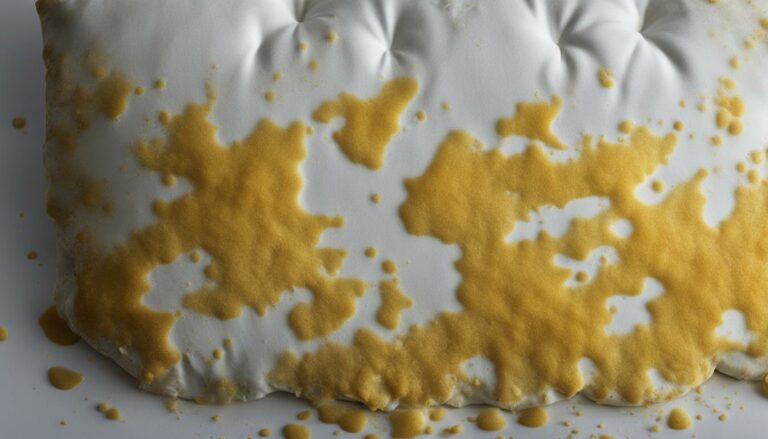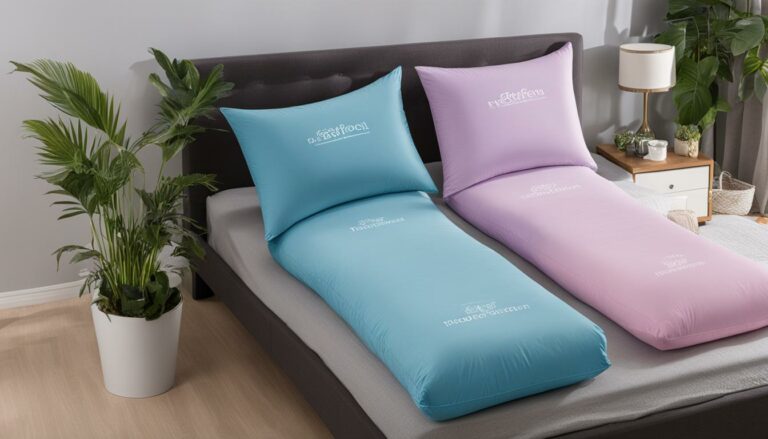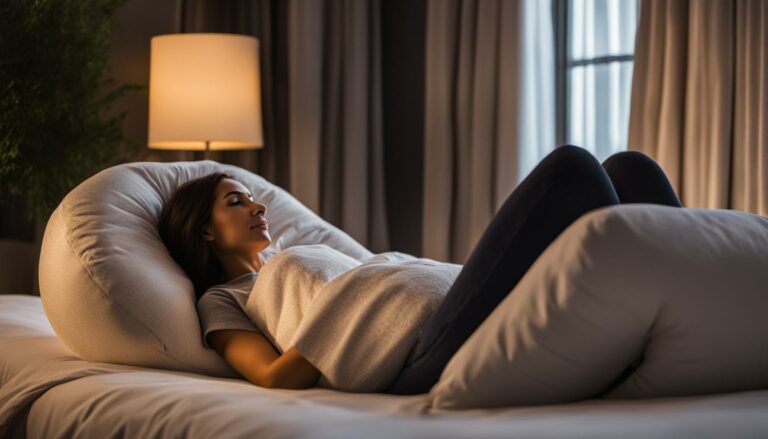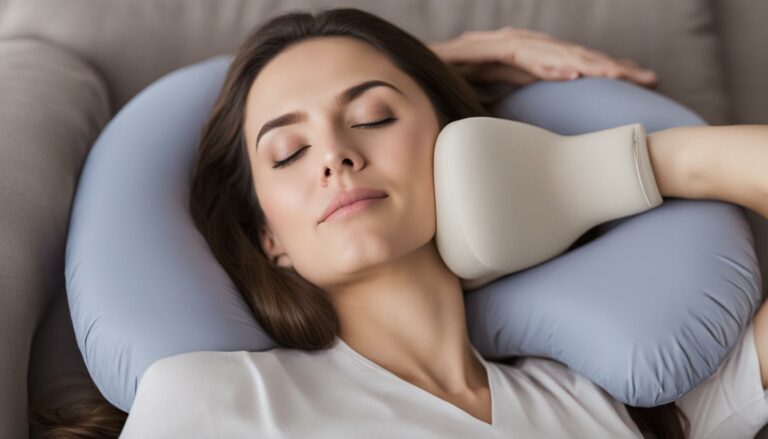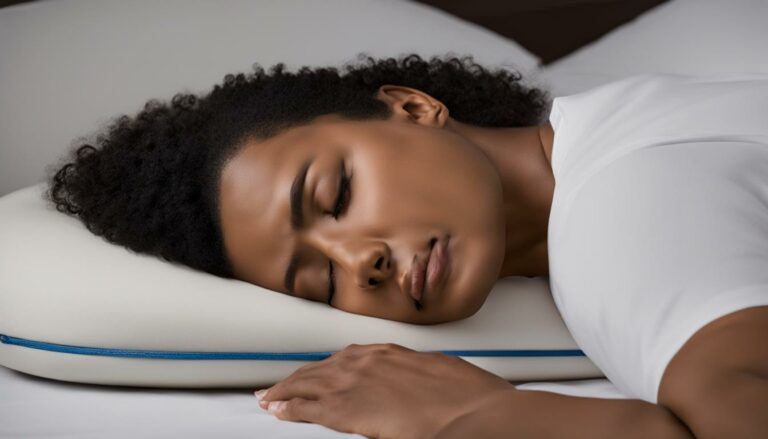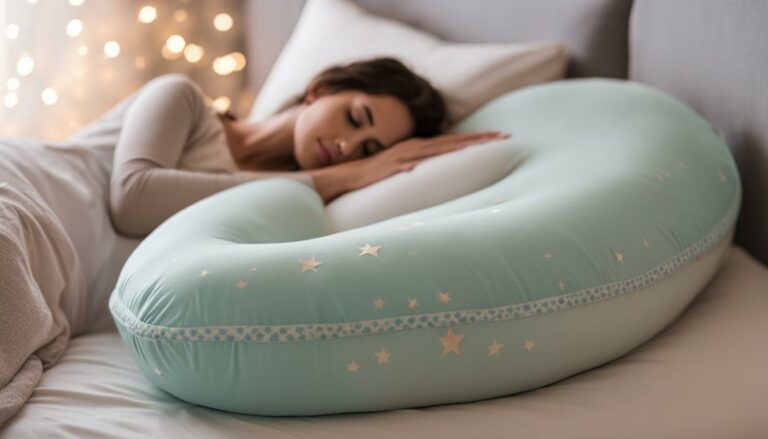Can Nits Survive on Pillows? Lice Infestation Guide
Eric Christie stands as a luminary in the bedding industry, with a career spanning nearly four decades since the early 1980s. His journey through the world of bedding has seen him wear many hats – a manufacturer, designer, and retailer, showcasing his versatility and expertise in Read more...
pillowsandbedsheets.com and its partners may earn a commission if you purchase a product through one of our links
Welcome to our comprehensive guide on lice infestations! Are you wondering if nits, the eggs of head lice, can survive on pillows? In this section, we will explore the lifespan of nits, shedding light on their survival capabilities and the potential risks associated with pillows.
Nits are typically found glued to the hair shaft close to the scalp. They hatch into nymphs (baby lice) in about 8 to 13 days and reach maturity as adult lice within 7 to 10 days. Adult lice can live for an average of 30 to 40 days. These blood-feeding pests need to feed several times a day to survive.
Although nits can lay their eggs on pillows or sheets, they cannot survive for long on these surfaces. A louse that falls off a person’s head onto a pillow may crawl onto another person who uses the same pillow, but the risk of infestation is minimal.
To further reduce the risk of lice transmission, it is recommended to vacuum or tumble dry pillows and sheets. If an infestation does occur, washing bedding in hot water and running them through the dryer can help eliminate lice and nits. Rest assured, the chances of nits surviving on pillows are very low.
Key Takeaways
- Nits, the eggs of head lice, are typically glued to the hair shaft near the scalp and hatch in about 8 to 13 days.
- Adult lice can live for about 30 to 40 days, requiring frequent blood meals to survive.
- While nits can be laid on pillows or sheets, they cannot survive for long on these surfaces.
- Reducing the risk of lice transmission involves vacuuming or tumble drying pillows and sheets.
- Washing bedding in hot water and running them through the dryer can help eliminate lice and nits.
Where Do Head Lice and Nits Come From?
Head lice and their eggs, or nits, primarily live on the human head and scalp. The eggs are laid close to the scalp and take about 8 to 13 days to hatch. Nymphs and adult lice can move from one person’s head to another, typically through head-to-head contact or sharing infected items. While it is possible for nits to be transferred onto pillows or sheets if hair with attached eggs falls out, the lice eggs cannot survive and hatch on these surfaces.
If you’re curious about the origins of head lice and nits, let’s explore their lifecycles. Head lice are tiny insects that infest human scalps, feeding on blood multiple times a day to survive. They lay their eggs, or nits, close to the scalp, usually within 6mm. These nits are small, oval-shaped, and stick to the hair shafts, making them difficult to spot. Over the course of about 8 to 13 days, the nits develop and hatch into nymphs.
The nymphs then mature into adult lice within 7 to 10 days. An adult louse can live for about 30 to 40 days, during which it continues to lay eggs. Head lice need a human host to survive, and without a blood supply, they will die within 24 to 48 hours.
Although head lice eggs can be deposited on pillows or sheets if infested hair falls out, it’s important to note that these eggs cannot survive or hatch on such surfaces. Head lice are specialized parasites that require specific conditions to thrive, including the warmth and proximity of the human scalp. Therefore, while nits may inadvertently end up on pillows or sheets, they cannot develop or cause infestations in those locations.
If you’re concerned about head lice infestations spreading through bedding or other items, rest assured that the risk is minimal. Lice are unlikely to crawl away from their human hosts, and the short lifespan of the eggs without a warm scalp makes it highly unlikely for infestations to start or continue on pillows or sheets.
Can Head Lice Live on Pillows or Sheets?
Although head lice cannot survive for an extended period on pillows or sheets, there is still a slight possibility that a louse that has fallen off a person’s head could crawl onto another person who uses the same bedding. However, it is important to note that lice typically do not stray far from their host.
To minimize the risk of catching head lice from pillows or sheets, there are precautionary measures you can take. One effective method is to vacuum or tumble dry pillows and sheets regularly. This helps remove any potentially stray lice or nits that may have fallen onto the bedding. By taking these steps, you can further reduce the chances of infestation.
If you do find an infestation of nits on your pillows, there are steps you can take to eliminate them. Firstly, wash the bedding in hot water to help kill the lice and nits. Additionally, running the bedding through a dryer on high heat can provide further eradication. By following these strategies, you can effectively get rid of the nits on your pillows and ensure a lice-free environment.
| Pillow Infestation with Nits: | Preventing Nits on Pillows: | Getting Rid of Nits on Pillows: |
|---|---|---|
| – Lice may fall onto pillows – Stray lice can crawl onto another person – Risk of catching lice is small |
– Vacuum or tumble dry pillows regularly – Minimize the risk of infestation – Ensure a lice-free environment |
– Wash pillows in hot water – Run pillows in the dryer on high heat – Eliminate lice and nits effectively |
Can Head Lice Spread Through Personal Items?
While head lice can be transmitted through shared personal items such as combs, brushes, hats, and headphones, the risk of spreading lice through bedding or toys is very low. Head lice need a human host to survive and do not live for more than 24 to 48 hours without feeding. Therefore, it is not necessary to wash or treat pillows, bedding, or toys if an infestation occurs. Vacuuming or bagging items for a few weeks can provide peace of mind, but it is not necessary for lice control.
Preventing Lice Spread through Personal Items
- Do not share hair combs, brushes, or other hair accessories.
- Avoid sharing hats, scarves, and other headwear.
- Discourage the sharing of headphones or earbuds.
- Wash and dry personal items regularly to maintain cleanliness.
By following these simple precautions, you can minimize the risk of lice spreading through personal items and help prevent further infestations.
Peace of Mind with Vacuuming and Bagging
While the risk of lice infestations from bedding and toys is low, some individuals may choose to take extra precautions for peace of mind. Vacuuming items, such as pillows and stuffed animals, or bagging them for a few weeks can provide an additional layer of reassurance. However, it is important to note that this is not necessary for lice control and should be done according to individual preference.
Remember, head lice primarily spread through direct head-to-head contact and not through inanimate objects. Focus on treating the infested individuals and taking preventive measures to reduce the likelihood of lice infestations.
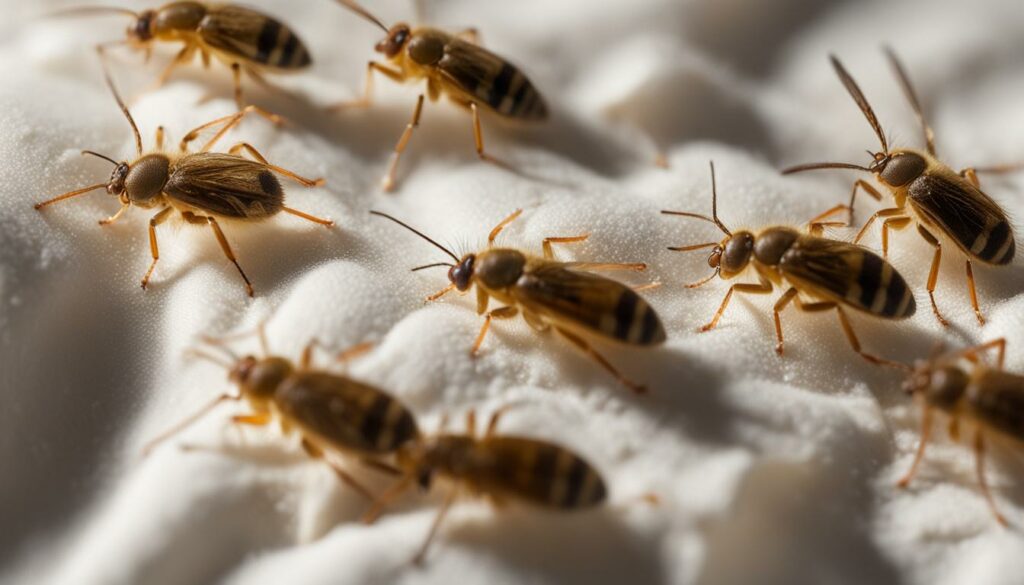
Personal Items and Lice Spread
| Personal Items | Risk of Lice Spread |
|---|---|
| Combs and brushes | Medium |
| Hats and headwear | Medium |
| Headphones and earbuds | Low |
| Pillows and bedding | Low |
| Toys and stuffed animals | Low |
As shown in the table, the risk of lice spread through personal items varies. It is important to prioritize personal hygiene and avoid sharing items that come into close contact with the hair and scalp to minimize the risk of lice infestation.
Can Head Lice Spread in Bathrooms or Swimming Pools?
Head lice cannot swim, fly, or jump, so the risk of catching lice in a bathtub or swimming pool is very low. Lice will go into a state of suspended animation when in water, remaining firmly attached to the hair. They can survive exposure to shampooing, rain, seawater, and swimming pools. It is more likely to transmit head lice by sharing towels with an infested person rather than through a shared bath or pool experience. It is not possible to catch head lice from pets, as they are specific to humans.
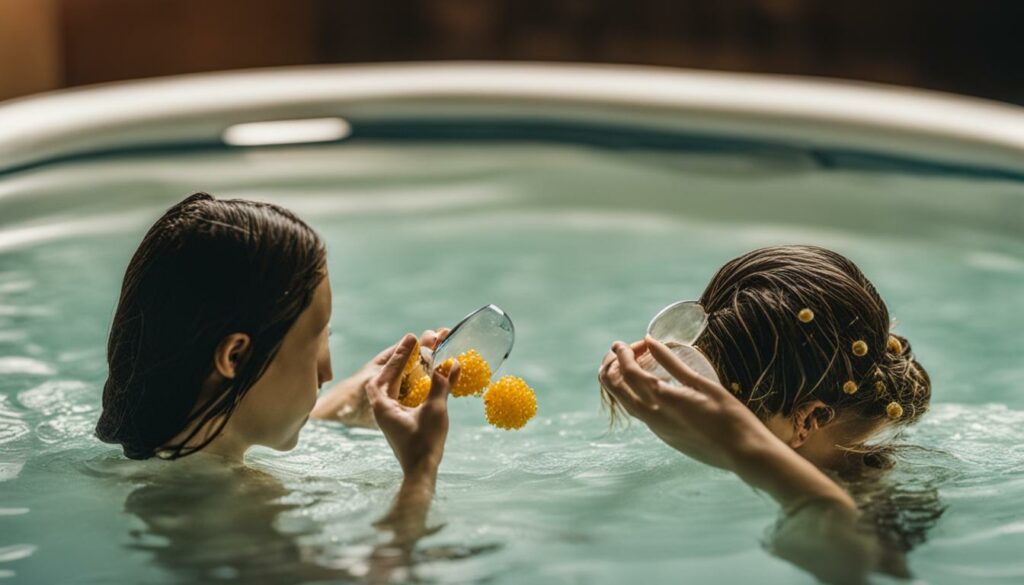
Do You Need to Fumigate or Treat the Entire House?
When it comes to dealing with head lice, there’s no need to go to extreme measures like fumigating or treating the entire house. Lice and nits, which are the eggs of head lice, cannot survive without feeding on a human host for more than 24 to 48 hours. This means that lice and nits are unlikely to infest your house or survive on surfaces such as furniture, carpets, or bedding.
However, it’s a good idea to take some precautionary steps to minimize the risk of lice infestation in your home. Vacuuming areas where an infested person has sat or laid down can help remove any stray lice or nits that may have fallen off. Pay close attention to upholstered furniture, mattresses, and car seats, as these areas can harbor lice.
When it comes to items like helmets, hats, or headphones, the risk of catching head lice from sharing them is very small. Lice prefer to stay close to the warmth and blood supply of the human scalp, so they are unlikely to be transferred through these items. However, to completely eliminate the risk, it’s best not to share personal items that come into contact with the head.
Remember, treating the infested person and their close contacts with appropriate lice treatments is key to getting rid of head lice. Focus on treating the hair and scalp, rather than treating the entire house.
There’s no need to fumigate or treat the whole house when dealing with head lice. Lice and nits cannot survive without feeding on a human host for more than 24 to 48 hours.
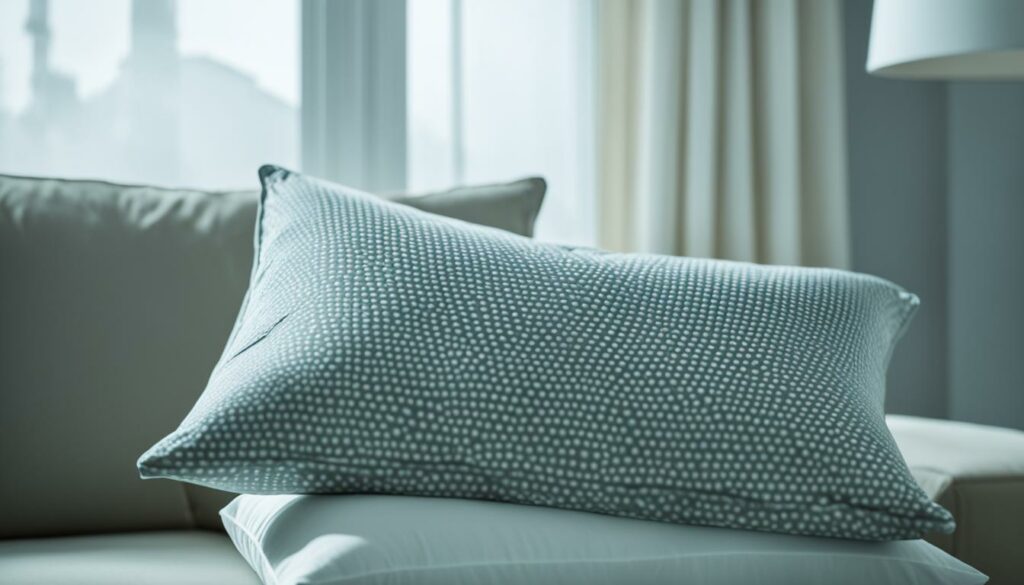
The Importance of Proper Treatment and Prevention
While you don’t need to fumigate your house, it’s important to take the necessary steps to effectively treat and prevent head lice infestations:
- Use an over-the-counter or prescription lice treatment product specifically designed to kill lice and nits.
- Follow the instructions carefully and repeat the treatment if necessary to ensure all lice and nits are eliminated.
- Regularly comb the hair with a fine-toothed nit comb to remove any remaining lice or nits.
- Encourage good personal hygiene practices, such as not sharing combs, brushes, hats, or towels.
- Teach children to avoid head-to-head contact with infested individuals.
- Regularly wash and dry clothing, bedding, and other items that have been in contact with an infested person on high heat to kill any lice or nits.
By taking these steps, you can effectively manage and prevent head lice infestations in your home without the need for excessive and unnecessary treatments.
How to Prevent and Reduce the Spread of Head Lice
While it is not always possible to completely prevent head lice infestations, there are some effective strategies you can adopt to reduce the risk of spreading lice. By following these tips, you can take proactive measures to protect yourself and your loved ones.
Minimize Head-to-Head Contact
Avoiding head-to-head contact with infested individuals is crucial in preventing the spread of head lice. Encourage children to maintain personal space and discourage activities that involve close proximity to others, such as sharing headphones or engaging in rough play. Emphasize the importance of maintaining personal boundaries to minimize the risk of lice transmission.
Avoid Sharing Head-Touching Items
- Combs
- Brushes
- Hats
- Towels
Sharing items that come into direct contact with the head can contribute to the spread of head lice. It is vital to educate yourself and your family on the potential risks associated with sharing these personal items. Remind children of the importance of using their own combs, brushes, and towels to maintain personal hygiene and reduce the likelihood of lice transmission.
Separate Personal Belongings
To further minimize the risk of spreading head lice, it is essential to separate personal belongings, such as clothing, bedding, and hats. This will help prevent any stray lice or nits from spreading onto these items and potentially infesting others. Regularly wash and vacuum items that have been in close contact with an infested person’s head to eliminate any lice or eggs that may be present.
Use Over-the-Counter Head Lice Repellents
“Using over-the-counter head lice repellents can provide an added layer of protection against the spread of head lice.” – Dr. Emily Johnson, Pediatrician
Over-the-counter head lice repellents can act as a preventive measure by repelling lice and reducing the risk of infestation. These products often contain natural ingredients, such as essential oils, that are known to deter lice. Consult with a healthcare professional or pharmacist to identify a suitable repellent for you or your family members.
| Tips for Reducing the Spread of Head Lice |
|---|
| Minimize head-to-head contact with infested individuals |
| Avoid sharing head-touching items like combs, brushes, hats, and towels |
| Separate personal belongings, such as clothing and bedding |
| Regularly wash and vacuum items that have been in close contact with an infested person’s head |
| Use over-the-counter head lice repellents |
By implementing these preventive measures, you can significantly reduce the spread of head lice and protect yourself and your loved ones from infestation. Stay vigilant and educate others about the importance of practicing good hygiene and taking proactive measures to prevent the spread of head lice.
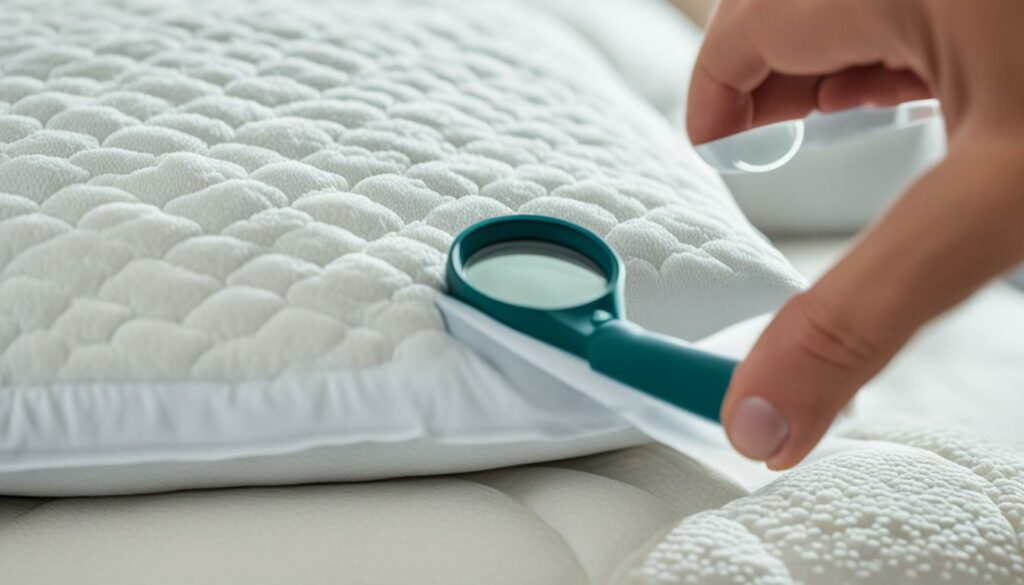
How to Get Rid of Head Lice on Pillows and Bedding
To effectively eliminate head lice on pillows and bedding, follow these simple steps:
- Start by washing the pillows and bedding in hot water. The high temperature will kill any stray lice or nits that may be present.
- After washing, run the pillows and bedding through a dryer on high heat. The heat will further ensure the elimination of any remaining lice or eggs.
- If you have items that cannot be washed, such as stuffed animals, seal them in a plastic bag for two weeks. This will suffocate any lice or eggs, eliminating the infestation.
- Remember, treating the infested person and their close contacts is crucial. Use an over-the-counter or prescription medication specifically designed to target head lice. Follow up with nit combing every 2-3 days to remove any remaining lice or nits from the hair.
By following these steps and taking appropriate measures, you can effectively get rid of head lice on pillows and bedding, ensuring a lice-free environment for you and your family.
How to Deal with a Lice Infestation
If you or someone you know is dealing with a lice infestation, it’s important to take prompt action. First, seek treatment for the infested person and their close contacts. Treatment options include using over-the-counter or prescription medications specifically designed to eliminate head lice. Additionally, wet combing with a nit comb can be an effective way to remove lice and nits from the hair.
To ensure all lice and nits have been eliminated, it’s recommended to check and comb the hair every 2-3 days for about 2-3 weeks. This helps to catch any remaining lice or newly hatched nits. Consistency is key during this process.
If the infestation persists or spreads despite these measures, it’s advisable to consult a healthcare provider for further guidance. They can provide personalized recommendations and may suggest alternative treatment options if necessary.
Dealing with a lice infestation can be frustrating, but with the right treatment and thorough combing, you can successfully eliminate these pesky parasites and prevent their recurrence.
FAQ
Can nits survive on pillows?
No, nits cannot survive on pillows. While head lice can lay their eggs on pillows or sheets, the eggs cannot survive and hatch on these surfaces.
Where do head lice and nits come from?
Head lice and nits primarily come from infested individuals through head-to-head contact or sharing infected items. However, nits cannot live for long on pillows or sheets.
Can head lice live on pillows or sheets?
No, head lice cannot live for long on pillows or sheets. The risk of catching head lice from these surfaces is very small, as lice do not typically crawl away from their host. Washing bedding in hot water and running them through the dryer can help eliminate lice and nits if an infestation occurs.
Can head lice spread through personal items?
The risk of spreading head lice through bedding or toys is very low. Head lice need a human host to survive and do not live for more than 24 to 48 hours without feeding. Vacuuming or bagging items for a few weeks can provide peace of mind, but it is not necessary for lice control.
Can head lice spread in bathrooms or swimming pools?
The risk of catching head lice in a bathtub or swimming pool is very low. Lice will go into a state of suspended animation when in water and remain firmly attached to the hair. It is more likely to transmit head lice by sharing towels with an infested person rather than through a shared bath or pool experience. It is not possible to catch head lice from pets, as they are specific to humans.
Do you need to fumigate or treat the entire house?
There is no need to fumigate the house or treat the entire house when dealing with head lice. Lice and nits cannot survive without feeding on a human host for more than 24 to 48 hours. However, it is recommended to vacuum areas where an infested person has sat or lay to remove any stray lice or nits. It is also advisable not to share helmets, hats, or headphones to eliminate the risk of spreading lice.
How to prevent and reduce the spread of head lice?
To reduce the risk of spreading head lice, minimize head-to-head contact with infested individuals, avoid sharing head-touching items like combs, brushes, hats, and towels, separate personal belongings, such as clothing, and regularly wash and vacuum items that have been in close contact with an infested person’s head. Using over-the-counter head lice repellents can also help prevent the spread of head lice.
How to get rid of head lice on pillows and bedding?
To get rid of head lice on pillows and bedding, wash them in hot water and run them through a dryer on high heat. The heat will kill any stray lice or nits. If there are items that cannot be washed, such as stuffed animals, they can be sealed in a plastic bag for two weeks to ensure any lice or eggs have died. It is also important to treat the infested person and their close contacts with an over-the-counter or prescription medication and follow up with nit combing every 2-3 days to remove any remaining lice or nits.
How to deal with a lice infestation?
During a lice infestation, seek treatment for the infested person and their close contacts. Treatment options include over-the-counter or prescription medications, as well as wet combing with a nit comb. It is recommended to check and comb the hair every 2-3 days for about 2-3 weeks to ensure all lice and nits have been eliminated. If the infestation persists or spreads, it is advisable to consult a healthcare provider for further guidance.
Eric Christie stands as a luminary in the bedding industry, with a career spanning nearly four decades since the early 1980s. His journey through the world of bedding has seen him wear many hats – a manufacturer, designer, and retailer, showcasing his versatility and expertise in Read more...


